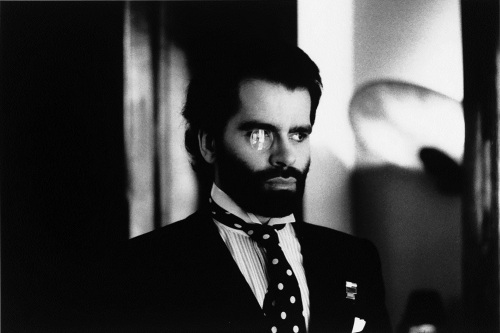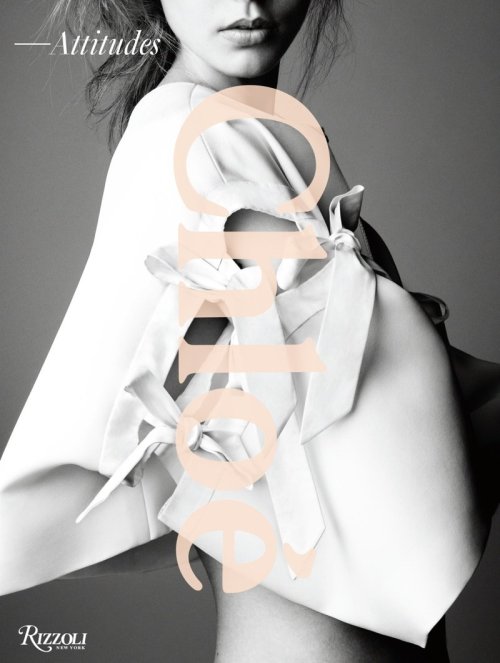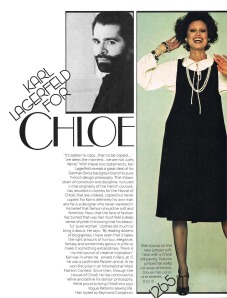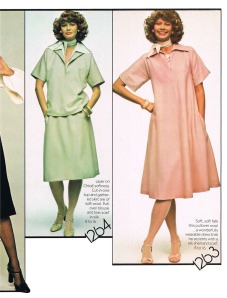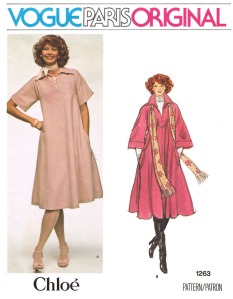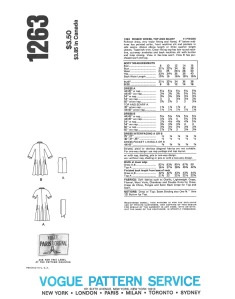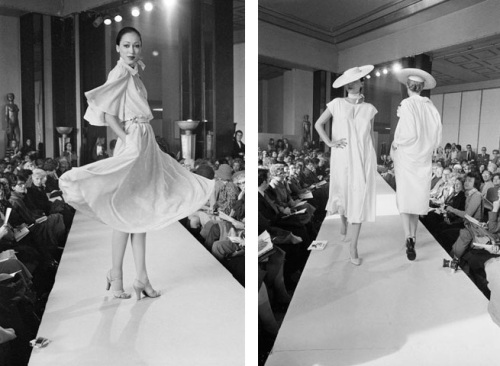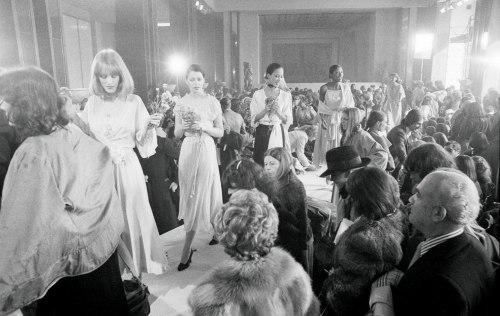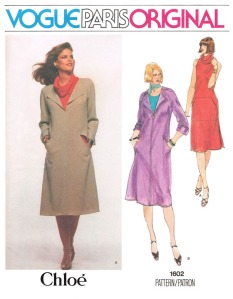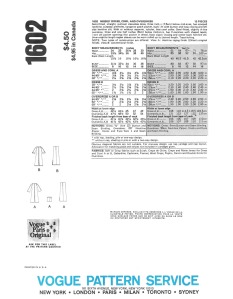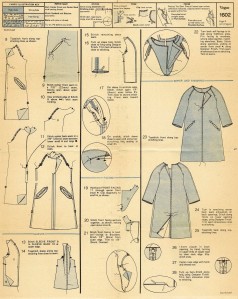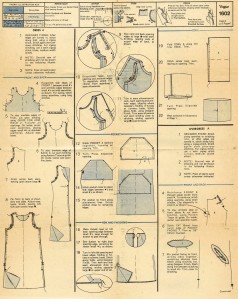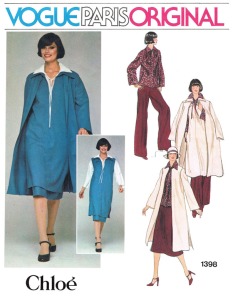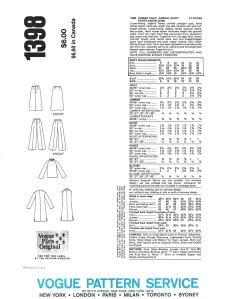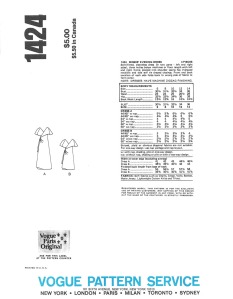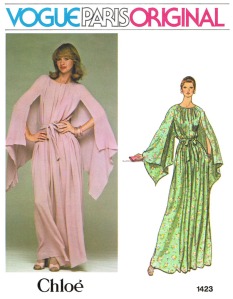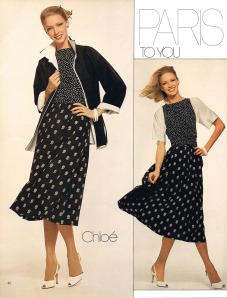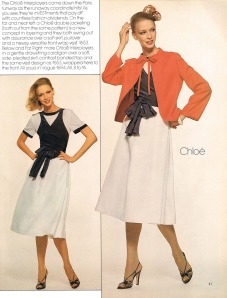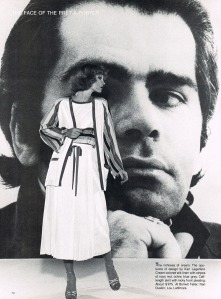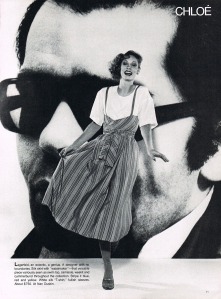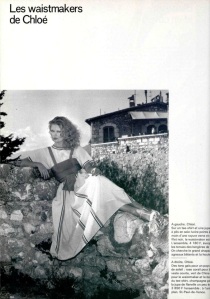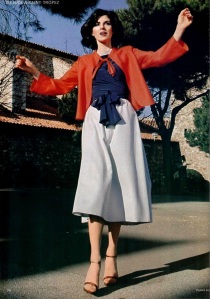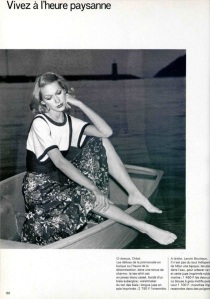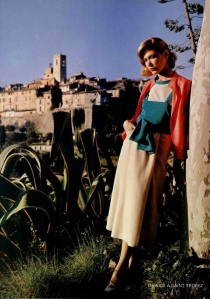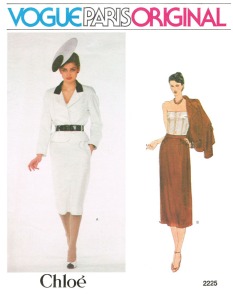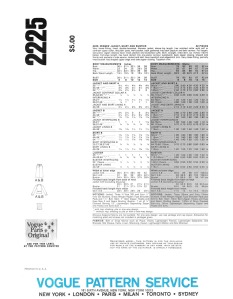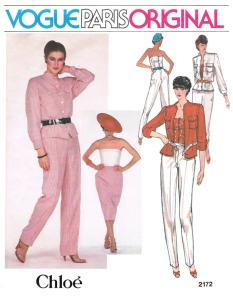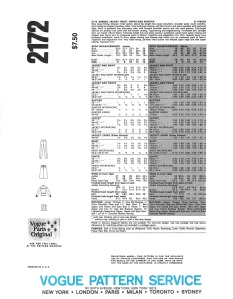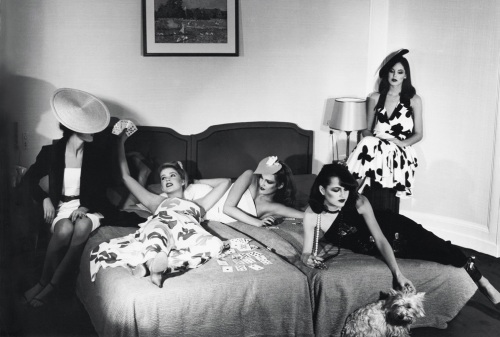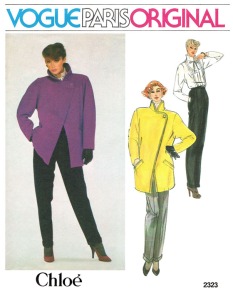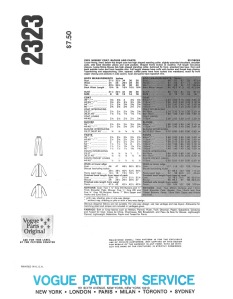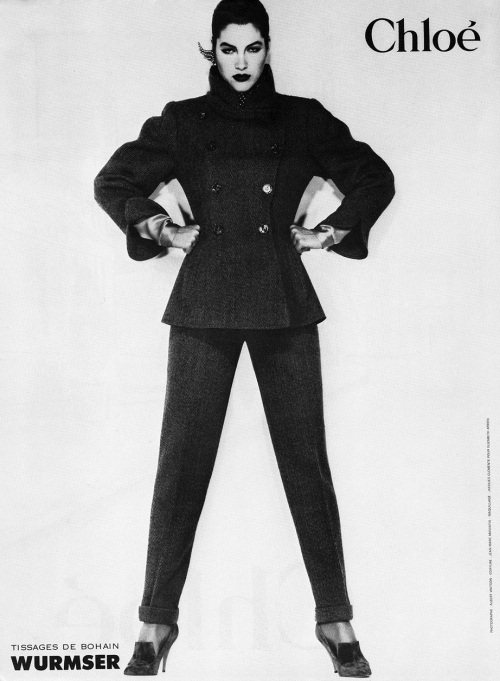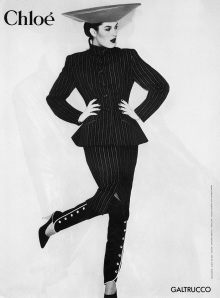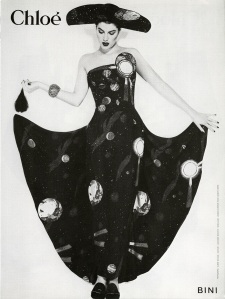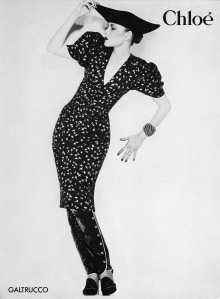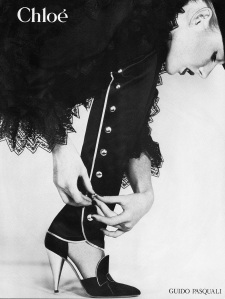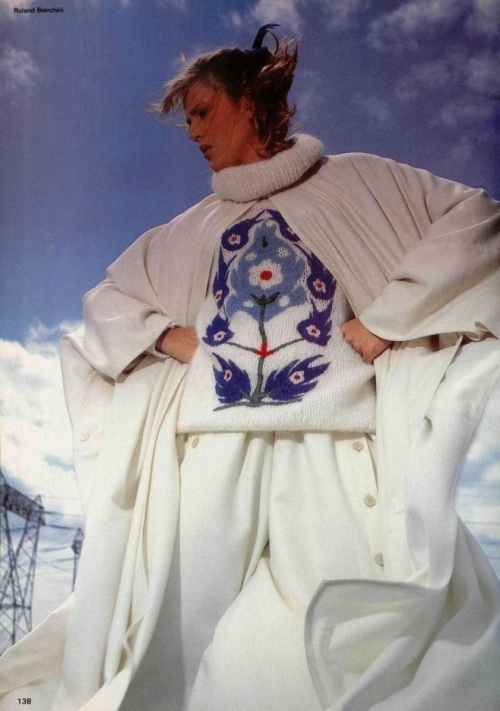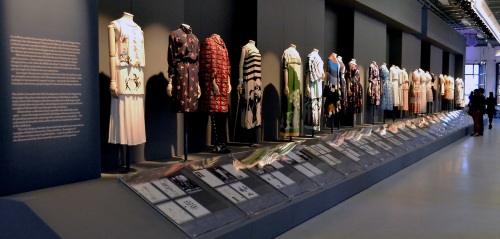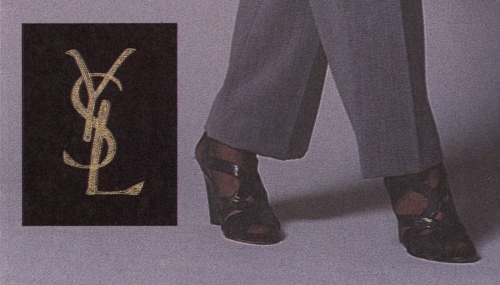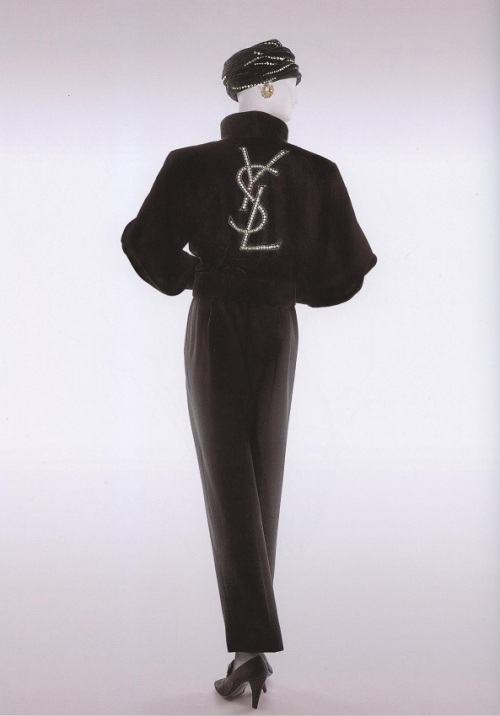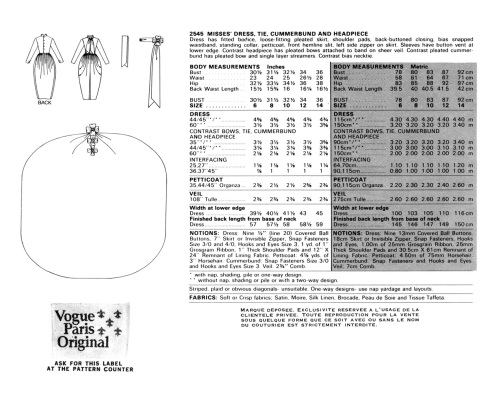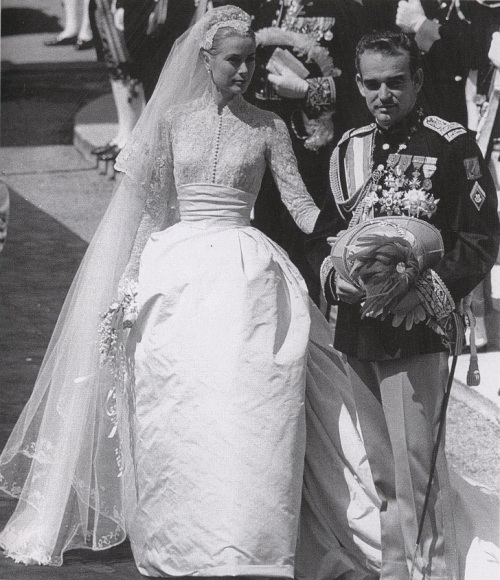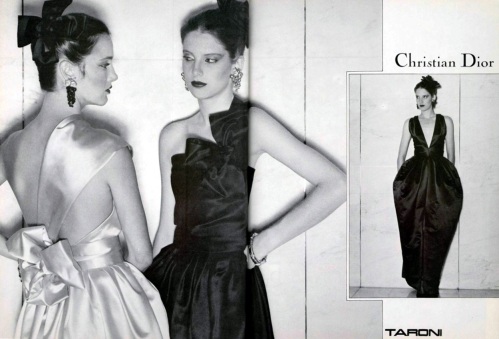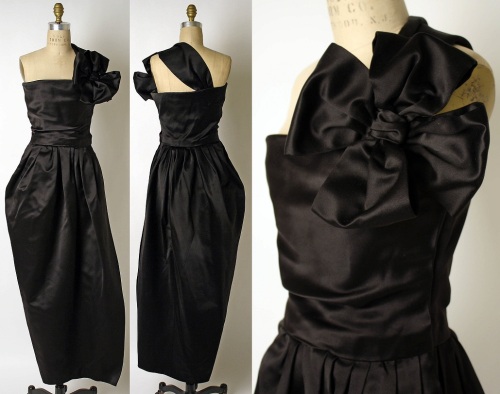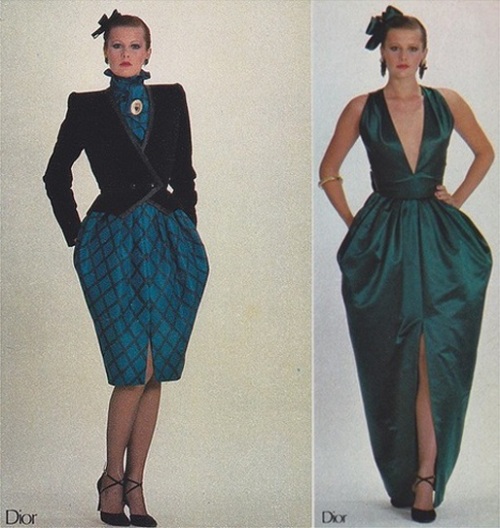Karl Lagerfeld Pour Chloé.
I’ve long been aware of Lagerfeld’s involvement as a designer with the Chloé label, and due to my pattern collecting I had become acquainted with those of his designs that were licensed to Vogue Patterns beginning in 1975. So I recently purchased the book ‘Chloé – Attitudes’ (released October 2013) in the hope of learning more about this period of the label’s history.
Usually I check out the latest books at two of my favourite book stores for art and fashion books in Sydney (Australia) when I go on a fabric-buying trip for myself to see if any books are worth buying. These trips don’t occur often as I live about four hours drive away from Sydney, but I have to travel that far as it is near impossible to find good fashion and art books and good fabric in rural Australia. I haven’t been to Sydney since early 2013 so I didn’t get a chance to check out ‘Chloé – Attitudes’ before making the purchase online (Occasionally I will buy a book from a bookstore but usually it’s much cheaper to buy online from overseas, and that’s including shipping! The prices of most imports in Australia are notoriously expensive compared to the rest of the world, and that’s with low or no tariffs in the name of free-trade!)
Anyhow, I took a chance and bought the book and was so excited when it arrived in the mail. I think my expectations were a little high as I was disappointed with, what seemed to be, a lack of content. On second and third viewings I came to value the book a little more, but I still feel that there could have been less empty white space and more pictures of the clothes and a little more detail in the text. Still, it would be impossible to cram sixty years of collections into one 273 page book.
The book vaguely captures the spirit of each period of the label’s history, beginning with the creation of the label by founder Gaby Aghion in the early 1950s (approximately 1952-1953) through to Karl Lagerfeld’s twenty year tenure from 1964 to 1984, and then following periods designed by several head designers up to 2013 (including Lagerfeld’s return from 1992 to 1997 which was practically glossed over and paid no attention).
Anyhow, back to Karl.
Lagerfeld came to Chloé with couture credentials after previously working with Pierre Balmain and at the house of Patou (see my previous post here) when he was hired as a designer for Chloé. When he started, he was part of a team of freelance stylistes (as Prêt-à-Porter designers were often called in those days to distinguish them from Couturiers) who collaborated to design two collections a year. However, although the collections were designed by a team, Lagerfeld’s individual designs were recognised by the press as early as 1965 when the first credit of “Karl Lagerfeld pour Chloé” appeared in Vogue Paris. Eventually, Lagerfeld became the sole designer to work with Gaby Aghion in the studio after the last of the other remaining designers left in 1972. He remained so until he left in 1984 to work for the house of Chanel.
In my opinion, Lagerfeld’s designs for Chloé could at once be fun, chic, sophisticated and novel. I have most of the Chloé patterns from the Lagerfeld era in my collection.
Vogue Patterns released its first Chloé patterns in 1975, which were selected from the Spring/Summer 1975 collection – a time when Lagerfeld was making soft ‘unconstructed’ clothes that were made from beautiful fabrics (as was always the case with the Chloé label) but without the structure of interfacings and interior finishes (such as linings) that would typically be found in Haute Couture garments. One finishing technique utilized at that time was a zig-zag stitch used on the fold of hems and garment edges or, in the case of leather and suede, raw edges instead of traditional hems and finishing techniques (this practice of the zig-zag stitch was also to be found on Sonia Rykiel’s garments from the same period).
Many of the earlier Chloé Vogue patterns featured this zig-zag stitch finishing technique (known as the ‘Original Chloe Finish’ or the ‘Designer’s Finish’) and this technique, along with the lightness and softness of the clothes, was noted in ‘Chloé – Attitudes’:
‘On October 22, 1974, a shocked and thrilled Women’s Wear Daily splashed front-page news that the Chloé collection for spring 1975 had:
Rocked the fashion professionals…. Karl Lagerfeld’s 200 trendsetting models do for unconstructed shapes what Balenciaga once did for constructed clothes…. he ties his delicate crepe blouses and shirts together with a soft scarf belt. He knots material together, lets the woman create the shape for these scarf dresse. He does filmy dresses in multiple layers…. he leaves everything unhemmedfinished with a simple overstitch. His big accessory is a scarf, appearing as a choker, a belt, an ankle-wrap.
‘The press raved about the lightness of lagerfeld’s techniques. Hebe Dorsey, doyenne of the International Herald Tribune, used superlatives:
Lagerfeld’s biggest talent lies in his unconstructed approach to fashion which rests on a deep understanding of fabric. With a minimum of seams, it looks as if his clothes have been put together by sheer magic. As of last season, he developed a new way of finishing his hems, which are cut clean instead of doubled over. There is not the slightest trace of lining…. Some dresses are nothing but a couple of rectangles, the front one folded over the back one…. as a result, everything floats.
Below is the two-page spread introducing ‘Karl Lagerfeld for Chloé’ from the July/August (or Early Autumn) 1975 issue of Vogue Patterns magazine with designs taken from Chloé’s Spring/Summer 1975 collection and, further down, views of the front and back envelope for Vogue pattern 1263. 1263 and 1264 have been accessorized with one of the essential Chloé accessories of the season – the scarf choker.
Below is an editorial spread from Vogue Paris, February 1975, and a page from American Vogue, February 1975, both showing clothes from Chloé’s Spring/Summer 1975 collection:
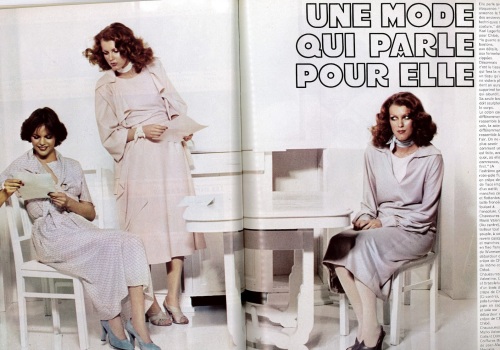
Vogue Paris, February 1975.
(Image from: http://www.ciaovogue.com)
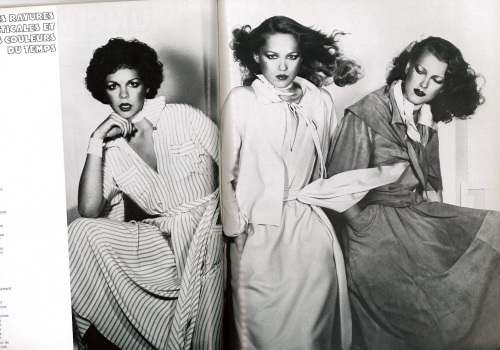
Vogue Paris, February 1975.
(Image from: http://www.ciaovogue.com)
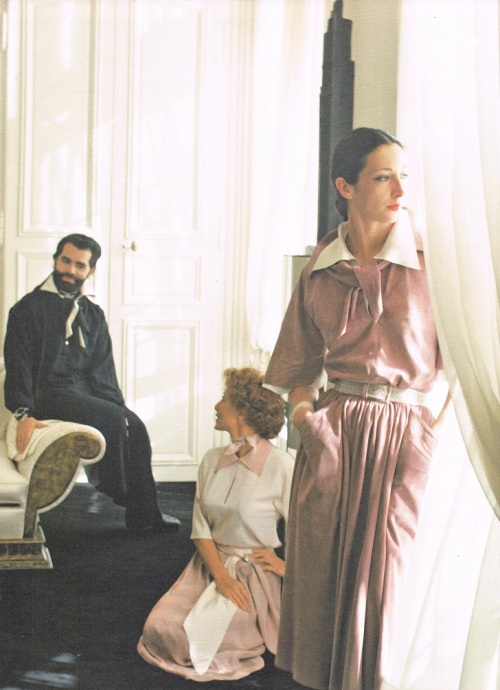
As shown in ‘Chloé – Attitudes’, this image is from a story shot by Deborah Turbeville at Karl Lagefeld’s home for American Vogue, February 1975. It was captioned:
‘The essence of modern dressing – unstructured, weightless, totally feminine…
Karl Lagerfeld says, “The basic idea is the simplest of all – a blouse and skirt. One must look twice to discover les raffinements de luxe.” Worn here in Karl’s apartment by Marie-France Acquaviva, his “right hand”, and French actress Stephane Audran. Stephan Audran, left, in one of Karl’s ravishing two-piece crepe de chines – the palest boise de rose blouse, two-tone sash, pleated skirt. Marie-France Acquaviva in the thinnest of thin suedes – without hems, without double stitching “suede that becomes skin again.”‘
Below, several photograph’s from the runway of Chloé’s Spring/Summer 1975 fashion show:
Below is a two-page spread taken from the Beauty section of Vogue Paris, May 1975. This spread announces the recent release of the first Chloé fragrance. The model is wearing a dress and scarf (tied around the wrist) from the Spring/Summer collection. Perhaps it is not just coincidence that Chloé singed a licencing deal for a perfume with Elizabeth Arden in 1975 and began licencing its designs to Vogue patterns the very same year… In the book The Beautiful Fall, by Alicia Drake, it is written:
In early 1975 Chloé and Karl Lagerfeld signed a lucrative perfume deal with Elizabeth Arden in the US to create the first Chloé fragrance. It was a crucial moment for Karl. For it is with this contract and the media profile and cash it generated that, for the first time in his career, Karl moved beyond being the hired hand at Chloé to receiving some of the profit share…
Significantly, Aghion (Gaby) and Lenoir (Jacques, Aghion’s husband and business partner) chose not to give him shares in the actual company of Chloé, but instead formed a new company with Karl called Karl Lagerfeld Productions, dividing the share count three ways, with 50 shares for Karl, 25 for Gaby Aghion and 25 for Jacques Lenoir. ‘It was supposed to be a company for licences,’ says Gaby Aghion, ‘for the perfumes and for the Karl Lagerfeld line which was launched in Japan only, not in Europe.’ That meant Karl’s profit share was on everything except the Chloé ready-to-wear.
Perhaps that included the revenue from the Vogue Patterns licence? And perhaps the Vogue Patterns deal was a sign of the company reaching out for a multitude of licencing opportunities, as had become the trend for large fashion companies at that time.
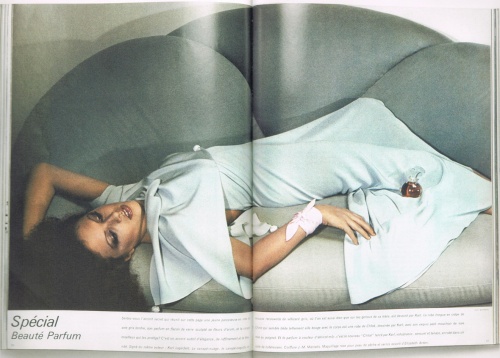
The organic rounded lines of the Chloé perfume bottle mimic the softness of the clothes from the collection.
Below is Vogue Pattern 1602 (with Lisa Taylor modelling on the front envelope). I’m not sure of the date for this pattern, but it is probably around 1976. I have included this pattern in this post especially to demonstrate the zig-zag-stitch finishing technique (or the ‘Original Chloé Finish’ or the ‘Designer’s Finish’) that was being used for the Chloé collections of the time. You will the find two pages of the instructions from 1602 that show the method of construction utilizing the zig-zag finish. It is used on everything except the separate detached cowl (which I think is really neat-o! Along with the slits in the outer-dress to access the corresponding pockets of the under-dress!)
Just so you know… 1602 also comes with instructions (and pattern pieces of facings) to construct the garments with traditional facings and hems.
FALL/WINTER 1975/76:
Below is Vogue pattern 1398, of which the design of the garments is similar to those of the Spring/Summer 1975 collection. I think this pattern was released some time in early 1976, along with Vogue pattern 1398 (also below). The envelope photos for both patterns seem to have been photographed in either the same photo shoot or around the same time as the model’s (Angeleen) hair style is the same for both and the blue hue of the clothes is similar.
Below is a photo by Helmut Newton which appeared in the December 1975 issue of Vogue Paris. I believe that the dress shown is the same design as Vogue pattern 1424 (above) except that the two separate overlapping wrap components of the dress below have been made from two contrasting colors. Therefore I believe that the dress design of 1424 and the designs from 1398 are from the Fall/Winter collection of 1975/76.
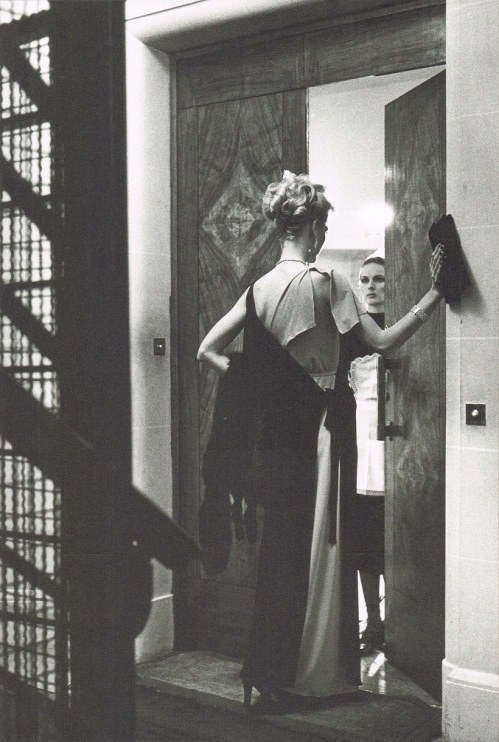
Also from ‘Chloé – Attitudes’, this photo was published in Vogue Paris, December 1975, and photographed by Helmut Newton. It was captioned:
“Long double crepe wraparound dress. One half of the dress is nude and the other half is black with identical décolleté at the front and back”.
This dress appears to be the same design as that of Vogue pattern 1424, only the two overlapping components of the dress are made from contrasting colors. This contrast two-tone effect could easily be replicated by the home sewer with pattern 1424 if desired.
Below is Vogue pattern 1423. I suspect it comes from the same collection (Fall/Winter 1975/76) as 1424. Consecutive pattern numbers (1423 & 1424) usually indicate that patterns were released at the same time. The zig-zag finish is also utilized with this design. The cape-like handkerchief sleeves are so dramatic and really make this design special.
SPRING/SUMMER 1977:
Below are editorial images in which a set of three Chloé patterns appeared in Vogue Patterns magazine for March/April 1977. All three patterns feature a wrapped waist, or ‘waist-maker’ in the form of wrap-around vests or an attachment that doubles as a shawl. Also, further down, are editorial images from the French and American issues of L’Officiel magazine showing variations of Chloé garments with the wrapped-waist, and emphasizing the ‘waist-maker’ as an important look for the Spring/Summer 1977 season.
SPRING/SUMMER 1979:
Below are three of my most favorite Chloé patterns and I believe the designs to be from from the Spring/Summer 1979 collection. Vogue 2172 and 2173 can be found in the May/June 1979 issue of Vogue Patterns magazine and 2225 in the July/August 1979 issue. In the editorial pages further down, similarities to the photographs on the front envelopes of 2225 and 2172 can be seen in the form of garment shapes and details, such as the bustier (a very important look in Paris for the season, according to L’Officiel USA, February 1979) and contrast collars, and accessories such as ‘cartwheel’ or ‘saucer’ hats.
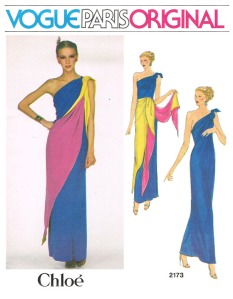
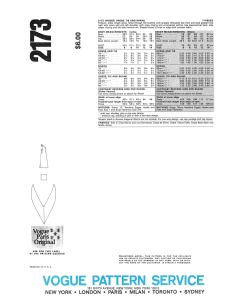
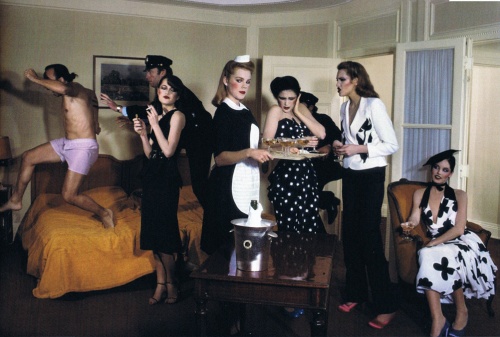
Vogue Paris, February 1979, Photogrpah by Guy Bourdin.

Gia Carangi models in these two images from a spread that appeared in British Vogue, April 1979. How exciting are the colors, textures and shapes of these clothes and accessories? I love those lacquered straw ‘cartwheel’ hats, they’re very glamorous!
(Images from: http://devorahmacdonald.blogspot.com.au)
FALL/WINTER 1979:
I found this pattern, Vogue 2323, really exciting when I first discovered its existence several years ago. The silhouette of the clothes combined with the model’s pose (Tara Shannon?) is so sharp, so dynamic. This pattern featured in the November/December 1979 issue of Vogue Patterns magazine so I believe it would be taken from Chloé’s Fall/Winter 1979/80 collection. Check out the Chloé ad campaign for the same season below (images from myvintagevogue.tumblr.com). The collar of the jacket in the first image correlates with the collar of the coat from pattern 2323, and the style of the pants is identical.
Don’t you just love the hats and, especially, the satin spats?
FALL/WINTER 1981/82:
Here is the Chloé offering from Vogue Patterns for Fall of ’81. Culottes seem to have been a big trend in the early ’80s, there were many designer patterns made available featuring culottes. This pattern, Vogue 2855, from Chloé has an interesting buttoned-down band detail on each leg, continuing down on the left from the asymmetric front opening of the blouse, also with asymmetric collar. I agree with Vogue Patterns‘ statement below of the ‘Artful Handling’ of the sometimes difficult-to-wear culottes. I like this pattern very much. I like the design, I like the styling and the accessories in the photo, and I like Terri May! (the lovely model).
This pattern, curiously, has at sometime been mislabeled in its production as being designed by Claude Montana (visit Vintage Pattern Wikia to see) but can also be found printed with the Chloé’ label on the envelope. Both versions were numbered as 2855.
I know of one other instance where a pattern has been printed with one of two different designer labels. Visit BCN-Unique Designer Patterns to take a look.
Below is a page taken from the french edition of L’Officiel (L’OFFICIEL DE LA MODE no676 de 1981). Notice the culottes? The cape and sweater are also by Chloé. The cape can also be seen in the illustration, further below, by Antonio that appeared in a 1981 issue of American Vogue. Also illustrated is a skirt with the same buttoned-down detail as the culottes, and a different bodice design with a variation of the buttoned-down front.
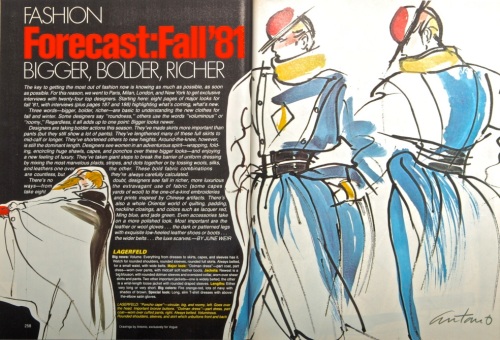
Antonio’s illustrations of Karl Lagerfeld’s designs for Chloé, US Vogue, 1981.
In 1984, Lagerfeld’s long tenure at Chloé ended, having been approached by Chanel to reinvigorate the old house (although he was to return to Chloé for a briefer period from 1992 to 1997). Lagerfeld’s last collection at Chloé was for the Spring/Summer season of 1984, so any Vogue patterns by Chloé released in late 1984 or early 1985 onward would likely have been designed by the many new and constantly-changing designers brought in after Lagerfeld departed.
Gaby Aghion, who worked with Lagerfeld for all of his twenty years said of him:
“It was a very, very big pleasure to work with him for so long…. Karl is a very talented man. And I think what he did during his time at Chloe made a big contribution to fashion history”.
The book ‘Chloé – Attitudes’ was released in October last year (2013) as a result of the 60 year anniversary of the house and the first retrospective exhibition of the label ever to be held, which took place at the Palais de Tokyo, Paris, in October of 2012.
To commemorate the anniversary, in early 2013 the house also reissued 16 key pieces from its extensive history to create the commemorative ‘Edition Anniversaire’ collection, which was available to buy at Paris retailer Printemps.
So, how about making your own ‘Edition Anniversaire’ piece from a vintage Vogue Chloé pattern? To see more Chloé patterns visit the Vintage Pattern Wikia.

